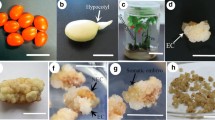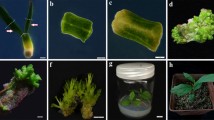Abstract
An efficient in vitro plant regeneration protocol through somatic embryogenesis and direct shoot organogenesis has been developed for pearl millet (Pennisetum glaucum). Efficient plant regeneration is a prerequisite for a complete genetic transformation protocol. Shoot tips, immature inflorescences, and seeds of two genotypes (843B and 7042-DMR) of pearl millet formed callus when cultured on Murashige and Skoog (MS) medium supplemented with varying levels of 2,4-dichlorophenoxyacetic acid (2,4-D; 4.5, 9, 13.5, and 18 μM). The level of 2,4-D, the type of explant, and the genotype significantly effected callus induction. Calli from each of the three explant types developed somatic embryos on MS medium containing 2.22 μM 6-benzyladenine (BA) and either 1.13, 2.25, or 4.5 μM of 2,4-D. Somatic embryos developed from all three explants and generated shoots on MS medium containing high levels of BA (4.4, 8.8, or 13.2 μM) combined with 0.56 μM 2,4-D. The calli from the immature inflorescences exhibited the highest percentage of somatic embryogenesis and shoot regeneration. Moreover, these calli yielded the maximum number of differentiated shoots per callus. An efficient and direct shoot organogenesis protocol, without a visible, intervening callus stage, was successfully developed from shoot tip explants of both genotypes of pearl millet. Multiple shoots were induced on MS medium containing either BA or kinetin (4.4, 8.8, 17.6, or 26.4 μM). The number of shoots formed per shoot tip was significantly influenced by the level of cytokinin (BA/kinetin) and genotype. Maximum rooting was induced in 1/2 strength MS with 0.8% activated charcoal. The regenerated plants were transferred to soil in pots, where they exhibited normal growth.






Similar content being viewed by others
References
Botti C.; Vasil I. K. Ontogeny of somatic embryos of Pennisetum americanum in cultured immature inflorescences. Can. J. Bot. 62: 1629–1635; 1983. doi:10.1139/b84-218.
Cai T.; Butler L. Plant regeneration from embryogenic callus initiated from immature inflorescences of several high-tanin sorghum. Plant Cell, Tissue Organ Cult. 20: 101–110; 1990. doi:10.1007/BF00114707.
Devi P.; Zhong H.; Sticklen M. B. In vitro morphogenesis of pearl millet [Pennisetum glaucum (L.) R. Br.]: efficient production of multiple shoots and inflorescences from shoot apices. Plant Cell Rep. 19: 546–550; 2000. doi:10.1007/s002990050771.
F. A. O. Production year book vol. 52, FAO. United Nations, Rome1998.
Goldman J. J.; Hanna W. W.; Fleming G.; Ozias-Akins P. Fertile transgenic pearl millet [Pennisetum glaucum (L.) R.Br.] plants recovered through microprojectile bombardment and phosphinothricin selection of apical meristem-, inflorescence-, and immature embryo derived embryogenic tissues. Plant Cell Rep. 21: 999–1009; 2003. doi:10.1007/s00299-003-0615-8.
Guo J. H.; Liang G. H. Callus induction and plant regeneration of cultivated and wild sorghums. Cytologia 58: 203–210; 1993.
Gupta S.; Khanna V. K.; Singh R.; Garg G. K. Effect of media and explant on callus formation and plant regeneration in sorghum. J. Plant Biol. 29: 39–44; 2002.
Haydu Z.; Vasil I. K. Somatic embryogenesis and plant regeneration from leaf tissues and anthers of Pennisetum purpureum Schumacher. Theor. Appl. Genet. 59: 269–273; 1981. doi:10.1007/BF00264978.
Lambe P.; Mutambel H. S. N.; Deitour R.; Dinant M. Somatic embryogenesis in pearl millet (Pennisetum glaucum): Strategies to reduce genotype limitation and to maintain long-term totipotency. Plant Cell Tissue Organ Cult. 55: 23–29; 1999. doi:10.1023/A:1026402229460.
Murashige T.; Skoog F. A revised medium for rapid growth and bioassay with tobacco tissue cultures. Physiol. Plant. 15: 473–497; 1962. doi:10.1111/j.1399-3054.1962.tb08052.x.
Mythili P. K.; Madhavi A.; Reddy V. D.; Seetharama N. Efficient regeneration of pearl millet (Pennisetum glaucum [L.] R. Br.) from shoot tip cultures. Indian J. Exp. Biol. 39: 1274–1279; 2001.
Mythili P. K.; Satyavathi V.; Kumar G. P.; Rao M. V. S.; Manga V. Genetic analysis of short term callus culture and in vitro morphogenesis in pearl millet, Pennisetum glaucum. Plant Cell Tissue Organ Cult. 50: 171–178; 1997. doi:10.1023/A:1005919306646.
O’Kennedy M. M.; Burger J. T.; Botha F. C. Pearl millet transformation system using the positive selectable marker gene phosphomannose isomerase. Plant Cell Rep. 22: 684–690; 2004. doi:10.1007/s00299-003-0746-y.
Oldach K. H.; Morgenstern S.; Rother S.; Girgi M.; O’Kennedy M.; Lorz H. Efficient in vitro plant regeneration from immature zygotic embryos of pearl millet [Pennisetum glaucum (L.) R.Br.] and Sorghum bicolor (L.) Moench. Plant Cell Rep. 20: 416–421; 2001. doi:10.1007/s002990100335.
Pius J.; George L.; Eapen S.; Rao P. S. Enhanced plant regeneration in pearl millet (Pennisetum americanum) by ethylene inhibitors and cefotaxime. Plant Cell Tissue Organ Cult. 32: 91–96; 1993. doi:10.1007/BF00040121.
Rajashekharan K.; Hein M. B.; Vasil I. K. Endogenous abscisic acid and indole-3-acetic acid and somatic embryogenesis in cultured leaf explants of Pennisetum purpureum Schum. Plant Physiol. 84: 47–51; 1987. doi:10.1104/pp.84.1.47.
Rao S. M. V.; Nitzsche W. Genotypic differences in callus growth and organogenesis of eight pearl millet lines. Euphytica 33: 923–928; 1984. doi:10.1007/BF00021922.
Vasil V.; Vasil I. K. Somatic embryogenesis and plant regeneration from suspension cultures of pearl millet (Pennisetum americanum). Ann. Bot. 47: 669–678; 1981a.
Vasil V.; Vasil I. K. Somatic embryogenesis and plant regeneration from tissue cultures of Pennisetum americanum, and P. americanum X P. purpureum hybrid. Am. J. Bot. 68: 864–872; 1981b. doi:10.2307/2443193.
Vasil V.; Vasil I. K. Characterization of an embryogenic cell suspension culture derived from cultured inflorescences of Pennisetum americanum (pearl millet, gramineae). Am. J. Bot. 69: 1441–1449; 1982. doi:10.2307/2443105.
Acknowledgments
We thank Professor S. K. Sopory, Plant Molecular Biology, ICGEB, New Delhi, for kindly going through the manuscript and for critical suggestions. We wish to duly acknowledge Dr. K. N. Rai, International Crops Research Institute for the Semi-Arid Tropics (ICRISAT), Patancheru, A. P., for providing the seeds of pearl millet for this study. We wish to thank Mr. S. K. Dass for the help with photography. Pooja Jha wishes to acknowledge Council for Scientific and Industrial Research India for financial assistance.
Author information
Authors and Affiliations
Corresponding author
Additional information
Editor: Susanna Devilliers
Rights and permissions
About this article
Cite this article
Jha, P., Yadav, C.B., Anjaiah, V. et al. In vitro plant regeneration through somatic embryogenesis and direct shoot organogenesis in Pennisetum glaucum (L.) R. Br.. In Vitro Cell.Dev.Biol.-Plant 45, 145–154 (2009). https://doi.org/10.1007/s11627-009-9198-6
Received:
Accepted:
Published:
Issue Date:
DOI: https://doi.org/10.1007/s11627-009-9198-6




